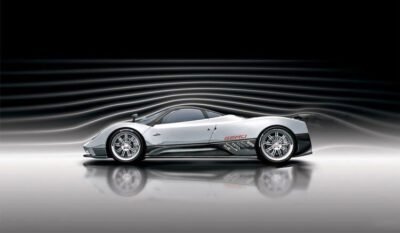Aerodinamiği otomobil tasarımına entegre etmek, aracın performansı ve verimliliği üzerinde önemli avantajlar sunar. İşte otomotiv
Incorporating aerodynamics into car design offers numerous advantages, significantly influencing both the vehicle’s performance and efficiency. Below are some key benefits of using aerodynamic principles in automotive engineering:
- Fuel Efficiency
Improved aerodynamics reduces air resistance against the vehicle. With less drag, the car requires less power to move, directly leading to better fuel economy. This is especially crucial for lightweight, city cars and vehicles designed for fuel efficiency.
- Increased Speed and Performance
By minimizing air resistance, aerodynamic design helps vehicles achieve higher speeds without demanding more power. This advantage is particularly important for sports cars and high-performance vehicles.
- Enhanced Stability and Control
Vehicles with better aerodynamic designs tend to be more stable at high speeds. The downforce generated by aerodynamic elements improves tire grip on the road, allowing for better handling in high-speed and sharp cornering situations.
- Reduced Wind Noise
Aerodynamic optimization decreases turbulence and airflow disruption around the vehicle. As a result, wind noise, especially at higher speeds, is significantly reduced, providing a quieter and more comfortable driving experience.
- Extended Range for Electric Vehicles
For electric cars, reducing air drag leads to lower energy consumption, which in turn extends the vehicle’s range. Aerodynamic designs help electric vehicles conserve battery power and enhance overall efficiency.
- Lower Environmental Impact
With better aerodynamics comes reduced fuel consumption, which means less emission of harmful gases. This is a significant step towards reducing the environmental footprint of automobiles, lowering greenhouse gas emissions, and mitigating climate change effects.
- Aesthetic Appeal
Aerodynamic designs contribute to sleeker, more modern-looking vehicles. Cars that incorporate aerodynamics often feature smooth, flowing lines, adding to their visual appeal and creating a stylish, contemporary appearance.
- Improved Safety
Certain aerodynamic components, such as spoilers and diffusers, help increase downforce and stability, enhancing safety in challenging driving conditions like slippery roads or high-speed scenarios.
- Reduced Heat Buildup in Systems
Proper airflow management through aerodynamic design can lower temperatures in the engine, brakes, and other critical systems. This leads to longer component life and improved overall performance.
Overall, aerodynamic design significantly improves a car’s efficiency, safety, and performance, making it an essential aspect of modern automotive engineering.

New Aerodynamic Technologies in Cars
The latest innovations in aerodynamic technology focus on improving fuel efficiency and reducing drag to boost vehicle performance. Below are some of the most advanced technologies currently used in car design:
- Active Aerodynamics
In this technology, movable components like spoilers, underbody panels, and air intakes automatically adjust based on speed and driving conditions. For instance, rear spoilers deploy at high speeds to enhance grip and stability, and retract at lower speeds to reduce drag.
- Smart Air Channels
“Air Curtains” or smart air channels guide airflow around the wheels and other parts of the body, reducing drag. These channels streamline the air around the vehicle, minimizing turbulence and improving efficiency.
- CFD Simulations (Computational Fluid Dynamics)
Car manufacturers use CFD simulations to optimize aerodynamic designs. This technology allows engineers to study airflow around vehicles and make design tweaks that reduce drag and enhance vehicle performance.
- Nanomaterials and Smart Coatings
Innovative coatings and nanomaterials are being applied to car surfaces to further reduce drag. These materials modify the body surface to allow smoother airflow, much like how hydrophobic coatings repel water.
- Electric Car Design
Electric vehicles (EVs) often feature aerodynamic designs since they don’t require large front grilles for cooling combustion engines. EV designs are typically smoother, with fewer openings, reducing drag and enhancing battery efficiency.
These technologies are helping manufacturers create vehicles that are more efficient, faster, and better suited to high-speed driving, without compromising stability.

Cars Utilizing Aerodynamic Technology
In recent years, many vehicles have embraced aerodynamic innovations to improve fuel efficiency, performance, and high-speed stability. Here are three examples of cars that stand out in this area:
- Active Aerodynamics
This technology uses movable parts like spoilers and air vents to optimize airflow:
- Porsche 911 Turbo (2021): Features adaptive front and rear spoilers that adjust based on driving speed to balance drag and downforce.
- Bugatti Chiron: Employs a rear spoiler and variable air intakes to enhance stability at extreme speeds.
- McLaren P1: Uses active aerodynamics in multiple areas, including an adjustable rear wing, to optimize both drag and downforce at high speeds.
- Smart Air Channels (Air Curtains)
These air channels help reduce turbulence around the vehicle:
- BMW i8: Incorporates smart air channels at the front and around the wheels to optimize airflow.
- Tesla Model 3: Uses air channels to reduce drag around the wheels, improving efficiency and range.
- Toyota Prius (4th Generation): This hybrid car uses air curtains to minimize wind resistance, making it one of the most aerodynamic vehicles in its class.
- Grille-less Designs in Electric Vehicles
Electric vehicles utilize sleek, grille-less designs to minimize drag:
- Tesla Model S Plaid: Features a smooth, grille-less front end, enhancing its aerodynamic efficiency.
- Audi e-tron GT: Incorporates streamlined surfaces and curved lines to reduce air resistance and boost range.
- Lucid Air: Boasts one of the lowest drag coefficients (cd = 0.21) in the industry, thanks to its smooth exterior and minimized openings.
These vehicles exemplify how modern aerodynamic innovations are transforming automotive design and performance.
Aerodynamic Software for Vehicle Design
For simulating airflow and optimizing vehicle designs, a range of Computational Fluid Dynamics (CFD) software is available. These tools help engineers refine aerodynamic performance by analyzing air movement, heat transfer, and turbulence around the vehicle. Some of the leading CFD software used in the automotive industry include:
- ANSYS Fluent
ANSYS Fluent is one of the most widely used CFD tools in automotive design, offering advanced simulations of airflow, heat transfer, and turbulence. It provides comprehensive solutions for optimizing vehicle aerodynamics and thermal management.
- STAR-CCM+
Produced by Siemens, STAR-CCM+ is a powerful CFD tool for simulating multi-phase flows, heat transfer, and aerodynamic performance. It’s widely used for vehicle optimization, particularly in aerodynamic and thermal management.
- OpenFOAM
As an open-source CFD tool, OpenFOAM is popular among engineers for its flexibility and customization options. It is commonly used for analyzing vehicle aerodynamics, turbulence, and heat transfer.
- AVL FIRE
AVL FIRE is specialized software for airflow and combustion simulations, often used in automotive engine design. It’s a go-to tool for optimizing engine cooling, aerodynamics, and combustion efficiency.
- SimScale
SimScale is a cloud-based CFD platform that allows users to perform aerodynamic simulations online. It is ideal for companies looking to perform complex CFD simulations without the need for expensive hardware.
- Altair AcuSolve
This CFD software uses a finite element method (FEM) to simulate complex flows and nonlinear behavior, making it a powerful tool for aerodynamic optimization and drag reduction.
- COMSOL Multiphysics
COMSOL offers multiphysics simulations, including fluid dynamics. It’s particularly useful when CFD analysis needs to be combined with heat transfer or structural mechanics.
- Autodesk CFD
Autodesk CFD is a user-friendly software popular among automotive designers for airflow and thermal management simulations. Its integration with other Autodesk tools makes it accessible to a wider range of engineers.
Each of these tools plays a crucial role in helping automotive engineers develop more efficient, aerodynamic vehicle designs.


